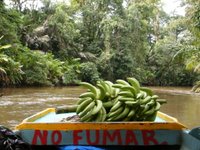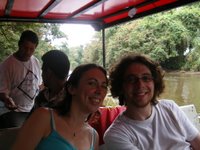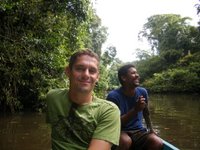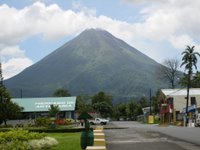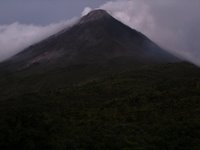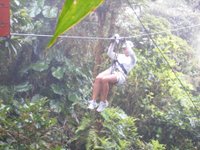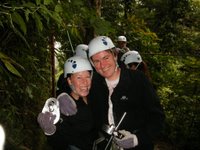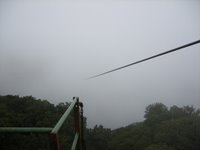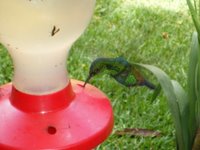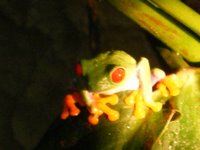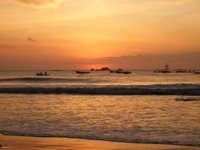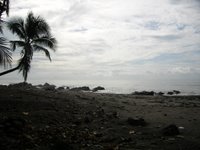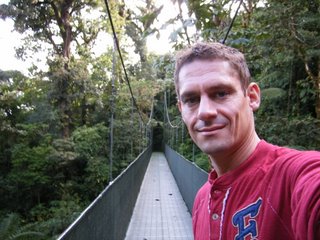Ecuadorian Doodlings
 I flew into Quito from Miami, and made my way to Casa Helbling, the German-run guesthouse I had chosen for my stay in Ecuador's capital. I was glad of my choice the following morning when I was served a breakfast of solid, dense Deutsche brot, good Deutsche käse, fruit juice and a whole thermos pot of strong, proper coffee - nothing "instant" about it! Especially since I had been missing European cheese for pretty much the whole trip so far, this place was quite a find in South America. Yum!
I flew into Quito from Miami, and made my way to Casa Helbling, the German-run guesthouse I had chosen for my stay in Ecuador's capital. I was glad of my choice the following morning when I was served a breakfast of solid, dense Deutsche brot, good Deutsche käse, fruit juice and a whole thermos pot of strong, proper coffee - nothing "instant" about it! Especially since I had been missing European cheese for pretty much the whole trip so far, this place was quite a find in South America. Yum!I met Australian Linda over such a breakfast, and then we set out to go a few kilometres north
 of the city to visit the equator. There is a monument and a visitor complex there called Mitad del Mundo, and also a quirky museum complex called The Inti Nan Solar Museum. I was really interested in seeing phenomena that only occur at the equator, like water going down a plughole vertically without forming a vortex. I remember seeing that demonstrated on tv when I was a kid, and ever since I had always wanted to see it in person! Science nerd? Yep, you betchya!
of the city to visit the equator. There is a monument and a visitor complex there called Mitad del Mundo, and also a quirky museum complex called The Inti Nan Solar Museum. I was really interested in seeing phenomena that only occur at the equator, like water going down a plughole vertically without forming a vortex. I remember seeing that demonstrated on tv when I was a kid, and ever since I had always wanted to see it in person! Science nerd? Yep, you betchya!So we went and saw the monuments and demonstrations. The first
 suspect thing about the whole place is that, as they now freely admit, Mitad del Mundo is not on the equator at all but is in fact several hundred meters away from it! When the complex was constructed in the thirties they were pretty sure that they had got it right, but in these days of GPS it is a little hard to hide the fact that they boo-booed.
suspect thing about the whole place is that, as they now freely admit, Mitad del Mundo is not on the equator at all but is in fact several hundred meters away from it! When the complex was constructed in the thirties they were pretty sure that they had got it right, but in these days of GPS it is a little hard to hide the fact that they boo-booed.The neighbouring Inti Nan Solar Museum claims
 to be exactly at 0 degrees latitude, and they have a red line painted on the ground where they claim the equator to be. We happened to be visiting on September 23rd, an equinox. On equinoxes the sun is in the earth's equatorial plane from sunrise to sunset, and so all shadows on the equator fall exactly along the equatorial line. This, at least, seemed to be true as far as their painted red line on the ground was concerned!
to be exactly at 0 degrees latitude, and they have a red line painted on the ground where they claim the equator to be. We happened to be visiting on September 23rd, an equinox. On equinoxes the sun is in the earth's equatorial plane from sunrise to sunset, and so all shadows on the equator fall exactly along the equatorial line. This, at least, seemed to be true as far as their painted red line on the ground was concerned! We saw this "demonstrated" by watching leaves twist anti-clockwise in water flowing down a plughole a couple of metres north, and clockwise a couple of metres south of the equator, followed by them going straight down when the bowl was placed on the museum's purported "equatorial line". I am afraid that my excitement at finally seeing a demonstration of this topic of childhood curiosity got in the way of my inherent scientific rationale; I really didn't want to see that the effect was actually being faked by the demonstrator....
We saw this "demonstrated" by watching leaves twist anti-clockwise in water flowing down a plughole a couple of metres north, and clockwise a couple of metres south of the equator, followed by them going straight down when the bowl was placed on the museum's purported "equatorial line". I am afraid that my excitement at finally seeing a demonstration of this topic of childhood curiosity got in the way of my inherent scientific rationale; I really didn't want to see that the effect was actually being faked by the demonstrator....A little research afterwards has convinced me that the Coriolis Effect is too weak to be observed in this way on such a small scale, and unfortunately is easily faked for tourists by charlatan museum guides by them subtly moving the water. Follow the below link to interesting web pages from the Penn State University College of Earth and Mineral Sciences on the subject if you want to know more..... or is it just me who finds this even remotely interesting?!? Very possibly....
http://www.ems.psu.edu/~fraser/Bad/BadCoriolis.html
 Anyway, the museum did also have an interesting collection of live and stuffed farm animals. The reason for this is somewhat obscure, (a special equatorial goat with wooden legs?!?), but they were very much appreciated.
Anyway, the museum did also have an interesting collection of live and stuffed farm animals. The reason for this is somewhat obscure, (a special equatorial goat with wooden legs?!?), but they were very much appreciated. Soon I left Quito for the main event as far as my time in Ecuador was concerned - the Galapagos Islands. I wasn't about to let the insane price tag of this part of the trip deter me from seeing such a unique wildlife reserve, where isolation has meant that many of the animals have developed with no natural fear of humans.
Soon I left Quito for the main event as far as my time in Ecuador was concerned - the Galapagos Islands. I wasn't about to let the insane price tag of this part of the trip deter me from seeing such a unique wildlife reserve, where isolation has meant that many of the animals have developed with no natural fear of humans.I
 t used to be distance that kept humans off the Galapagos archipelago; now the Ecuadorian government try to limit numbers of visitors by controlling the cost of a visit. The return plane fare from Quito is US$330, (much more than other comparable domestic fares in Ecuador), the cruises around the islands are usually at least US $900 and the authorities charge you US$100 just
t used to be distance that kept humans off the Galapagos archipelago; now the Ecuadorian government try to limit numbers of visitors by controlling the cost of a visit. The return plane fare from Quito is US$330, (much more than other comparable domestic fares in Ecuador), the cruises around the islands are usually at least US $900 and the authorities charge you US$100 just to land there, (payable in cash as you get off the plane!). As if I hadn't paid enough, the airline bus from the airstrip to the town of Puerto Ayoura took off without me, and I had to hitch a ride with a minibus full of highly amused but helpful national park employees and customs agents.
to land there, (payable in cash as you get off the plane!). As if I hadn't paid enough, the airline bus from the airstrip to the town of Puerto Ayoura took off without me, and I had to hitch a ride with a minibus full of highly amused but helpful national park employees and customs agents.The boat, The New Flamingo, was one of the cheapest I could find and
 I booked an eight-day cruise to try to see as many sites on the islands as possible. But first, there was diving to be done! Diving in the coldest water I have ever encountered, having only sampled Thai, Costa Rican, Vietnamese and Mexican waters, necessitated a full-length 7mm two-piece wetsuit, hood, booties and gloves! The four dives we did over two days were good, and I didn't get cold, which for me would kill the joy in any dive.
I booked an eight-day cruise to try to see as many sites on the islands as possible. But first, there was diving to be done! Diving in the coldest water I have ever encountered, having only sampled Thai, Costa Rican, Vietnamese and Mexican waters, necessitated a full-length 7mm two-piece wetsuit, hood, booties and gloves! The four dives we did over two days were good, and I didn't get cold, which for me would kill the joy in any dive.We saw some great marine life, especially white-tipped reef
 sharks and some wonderfully playful sealions! The sealions are excellent when you are diving. They love the bubbles divers make, and play with you by swimming straight towards you really fast, then just when they are about to crash into you they flip over on their backs and swim away. They can really shift underwater as well, reaching up to about 30
sharks and some wonderfully playful sealions! The sealions are excellent when you are diving. They love the bubbles divers make, and play with you by swimming straight towards you really fast, then just when they are about to crash into you they flip over on their backs and swim away. They can really shift underwater as well, reaching up to about 30  mph when they like. Fortunately I had an underwater camera with me, so I could capture one as it charged towards me. While diving I met American Cheree who liked to drink, (see picture), so in the evenings we went and did just that.
mph when they like. Fortunately I had an underwater camera with me, so I could capture one as it charged towards me. While diving I met American Cheree who liked to drink, (see picture), so in the evenings we went and did just that.So then it came to the Galapagos tour. My fellows on the cruise were a diverse and very pleasant bunch: American Mike, Swiss Marco, Dutchies Saskia and Hans, Italian Rene and his wife, Swedish Ida and Kristian, American Petra and our guide,
 Ecuadorian Alphonso. The boat was adequate, and even had hot water in the showers now and again! It was during my time on The New Flamingo that the full extent of the creeping travel fatigue that I had been feeling for a month or two began to hit home. As a result I would not, from that point onwards on my trip, accept the concept of a cold shower, and "¿por que no hay agua caliente en la ducha?" became my mantra...
Ecuadorian Alphonso. The boat was adequate, and even had hot water in the showers now and again! It was during my time on The New Flamingo that the full extent of the creeping travel fatigue that I had been feeling for a month or two began to hit home. As a result I would not, from that point onwards on my trip, accept the concept of a cold shower, and "¿por que no hay agua caliente en la ducha?" became my mantra... islands, including Isla Santiago, Isla Santa Cruz, Isla Rabida, Isla Baltra, Isla Santa Fe, Isla Santa Maria, Isla Seymour and Isla Espanola. What I had been told was true; so many of the animals had not been around humans for so many hundreds of generations, that they had no fear of
islands, including Isla Santiago, Isla Santa Cruz, Isla Rabida, Isla Baltra, Isla Santa Fe, Isla Santa Maria, Isla Seymour and Isla Espanola. What I had been told was true; so many of the animals had not been around humans for so many hundreds of generations, that they had no fear of  us and we could go right up to them. There were so many iguanas underfoot that you had to be careful not to tread on them. The sealions on the beaches would just let you lie down and bask in the sun next to them, (except the macho alpha males who will bark at and chase
us and we could go right up to them. There were so many iguanas underfoot that you had to be careful not to tread on them. The sealions on the beaches would just let you lie down and bask in the sun next to them, (except the macho alpha males who will bark at and chase 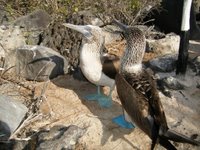 anything that isn't one of their harem!). The blue-footed boobies did their funny lift-your-feet-in-the-air mating dance while we all stood a couple of feet away. Frigate birds nesting and puffing up their big red throat pouches were mere steps away. Even some birds that were wary of humans, like albatrosses that had previously been captured and
anything that isn't one of their harem!). The blue-footed boobies did their funny lift-your-feet-in-the-air mating dance while we all stood a couple of feet away. Frigate birds nesting and puffing up their big red throat pouches were mere steps away. Even some birds that were wary of humans, like albatrosses that had previously been captured and  studied, were still close enough to have a good look at. Not to mention the ancient giant tortoises, crabs, insects, fish, flamingoes, penguins.....
studied, were still close enough to have a good look at. Not to mention the ancient giant tortoises, crabs, insects, fish, flamingoes, penguins..... So my birthday was spent at Black Turtle Cove on Isla Santa Cruz, and on Isla Seymour. In the evening after dinner, the boat's cook had made a cake with my name and
 a candle on it, and everyone sang. How nice... I still am not sure how they knew! I had deliberately timed the cruise so that I would be in the Galapagos on my birthday to ensure that I was doing something memorable, and it was a great way to turn 39!
a candle on it, and everyone sang. How nice... I still am not sure how they knew! I had deliberately timed the cruise so that I would be in the Galapagos on my birthday to ensure that I was doing something memorable, and it was a great way to turn 39!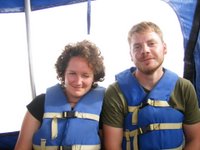 boat from Puerto Ayora on Santa Cruz to Isla Isabela to spend a day or two. The boat was something of a trial, being three hours in a little speed boat, constantly jumping up on the waves and then slamming down, over and over!! We got to Isabela with stomachs thoroughly shaken but contents intact, and stayed for a couple of nights. The main purpose of the visit
boat from Puerto Ayora on Santa Cruz to Isla Isabela to spend a day or two. The boat was something of a trial, being three hours in a little speed boat, constantly jumping up on the waves and then slamming down, over and over!! We got to Isabela with stomachs thoroughly shaken but contents intact, and stayed for a couple of nights. The main purpose of the visit  was to climb the volcano which the others did the next day, but I felt ill and stayed in the town. Apparently I didn't miss too much and we left the next day, having been regaled over and over at dinner by the locals' amateur video footage of recent eruptions.
was to climb the volcano which the others did the next day, but I felt ill and stayed in the town. Apparently I didn't miss too much and we left the next day, having been regaled over and over at dinner by the locals' amateur video footage of recent eruptions.So then back to Quito. I was beginning to like Quito, despite the local advice that to go anywhere in Quito after 6 p.m. you should take a cab, no matter how short the distance. It was also in spite of the weird sight of black-clad, SWAT-Team type private security guards, with full body armour and pump action shotguns, employed to guard...... erm.... banks? No. Jewellers? No. Ordinary pharmacies and restaurants? Yep. Hmmmm. It certainly runs against common sense to enjoy spending your free time in such a place, but there was something about the city that I liked. Either way it is perhaps as well, as the limited transport connections in Ecuador subsequently ensured that I would return to it over and over!
 The next stop after Quito was Banos to the south, in the company of American Mike. One almost-missed bus and one foiled hand-luggage snatch later, we arrived in this Ecuadorian town which lives in the shadow of a (very) active volcano. It was so active when we arrived that the locals were standing
The next stop after Quito was Banos to the south, in the company of American Mike. One almost-missed bus and one foiled hand-luggage snatch later, we arrived in this Ecuadorian town which lives in the shadow of a (very) active volcano. It was so active when we arrived that the locals were standing  in the street, pointing and looking at the huge column of smoke and ash that it was belching out!
in the street, pointing and looking at the huge column of smoke and ash that it was belching out!We hooked up with some people that Mike knew, and the next day took a downhill bike ride through some beautiful scenery and waterfalls. The following day Mike continued south by bus while I tried to get to the coast, failed, and ended up back in Quito. As I said, it was a good thing I was getting to like it there!
My next attempt to get to the Ecuadorian coast was an eight-hour bus ride to the small village of Canoa. This was one of the most uncomfortable eight hours of my life. Sitting at the front of a crappy bus with nowhere to put my long European legs except in front of me into the doorway to the cab; passengers and vendors constantly getting on and off and banging into them; insufficient stops for food and rest, and a conductor who insisted the vehicle door remain open despite deteriorating weather conditions, causing the whole bus to become freezing whilst up in the mountains.
After a short stay in unremarkable Canoa, I took a similar bus back to Quito except that you can add to the list a putrid smell throughout the bus due to the fact that a small child had fouled
 itself. Like I say, insufficient rest stops. The journey back to Quito had started out well enough though, with the first few miles undertaken on the roof of a classic South American chicken bus, (see the claws of the unfortunately still-alive creatures tried to the bar on the vehicle roof in the photo).
itself. Like I say, insufficient rest stops. The journey back to Quito had started out well enough though, with the first few miles undertaken on the roof of a classic South American chicken bus, (see the claws of the unfortunately still-alive creatures tried to the bar on the vehicle roof in the photo).So that was Ecuador; remarkable for its incomparable Galapagos Islands, its interesting approach to in-store security and its (quite literally) shitty buses. ¡Gracias Ecuador, y hasta Peru, amigos!


 So I ordered a new one from the UK website, had it delivered to a friend in the UK who had all my itunes backed up, and he loaded it and mailed it out to the UK consulate in Miami! Bless them for taking delivery of it; I knew I paid my taxes for something. Or I used to, when I worked. And big up Simon, of course, for taking care of business in London and saving me from a musical void out here. No thanks, however, to Apple, for flogging hardware which breaks when you look at it the wrong way..... I have now had six different ipods in 18 months.
So I ordered a new one from the UK website, had it delivered to a friend in the UK who had all my itunes backed up, and he loaded it and mailed it out to the UK consulate in Miami! Bless them for taking delivery of it; I knew I paid my taxes for something. Or I used to, when I worked. And big up Simon, of course, for taking care of business in London and saving me from a musical void out here. No thanks, however, to Apple, for flogging hardware which breaks when you look at it the wrong way..... I have now had six different ipods in 18 months.
